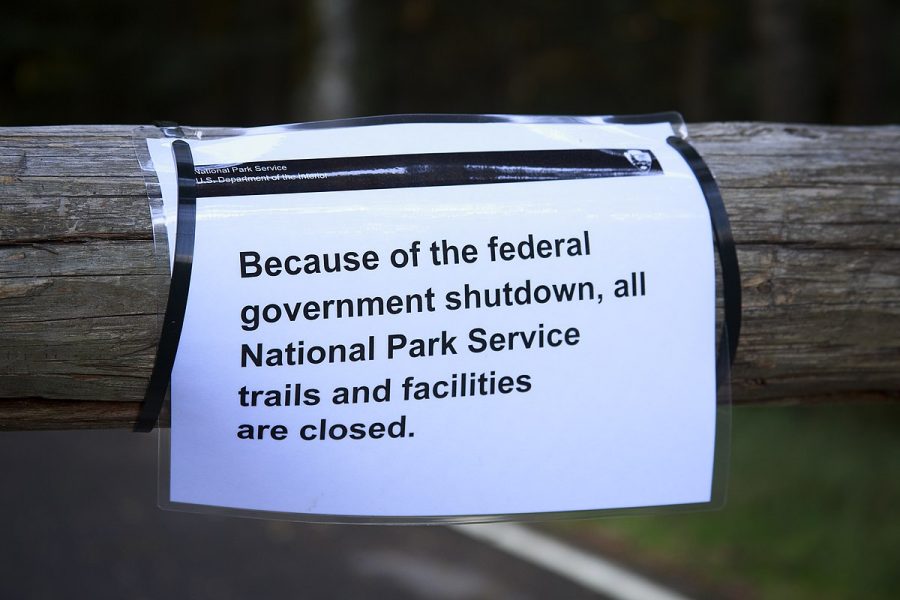Record-breaking government shutdown impacts students, teachers
The record-breaking government shutdown, which began on Dec. 22, 2018, ended on Jan. 25, 2019. The shutdown had unexpected impacts on students and teachers during and after winter break and left around 800,000 government workers around the country without pay. Around 400,000 of these federal employees continued to work expecting compensation for their hours through I Owe Yous (IOU) upon the reopening of the government; Congress formalized this promise by passing a bill that guaranteed back pay for furloughed workers on Jan. 11. Federally owned facilities and associations that have been affected included the Transportation Security Administration (TSA), national parks, public health, food assistance and law enforcement. As students and teachers traveled throughout winter break, some experienced the effects of the shutdown firsthand.
Senior Avery Lythcott-Haims flew home out of Newark on Jan. 6 after her flight had been delayed several times due to the shutdown. “Our flight was delayed a total of four hours in the airport,” Lythcott-Haims said. “All of the flights to San Francisco that day were pushed back, starting with the very first one.” After consulting with customer service, who claimed that the understaffing of air traffic controllers at San Francisco International Airport (SFO) caused the delay, she discovered that every flight was full and had been delayed as well. SFO air traffic controllers, in an interview with KQED on Jan. 11, revealed that SFO’s staff support specialists, who provide quality assurance and event analysis, had been furloughed. While necessary employees were showing up to work and working overtime to compensate for understaffing, an air traffic controller said that two more missed paychecks could cause financial problems that may prompt them to seek employment elsewhere. These changes may not pose an immediate safety threat, but the interviewee admitted that these setbacks were slowly paving the way for future safety issues. This is not an issue unique to SFO, as airports all over the country suffered from the understaffing of TSA agents and air traffic controllers.
National parks and its visitors also felt the burden of the shutdown. Math teacher Rachel Congress experienced the government shutdown’s toll while on a school field trip to Yosemite National Park. Congress has visited Yosemite many times before, but had never experienced conditions so unusual. Instead of the usual park entrance fee of $30-$35, the park was free for all visitors and was without the protection of any park security or rangers. “We saw people trampling fragile meadows, chasing and whistling at coyotes. One tourist was flying a drone, which is illegal in national parks,” Congress said. All restrooms were closed, only one restaurant was open and a single shuttle bus was running through the valley. The field trip was originally planned to begin on Monday, Jan. 14 and to end on Friday, Jan 18. However, the park sent out an order that advised visitors to leave Yosemite by Wednesday afternoon due to incoming weather. The possibility of a rock slide, flash flooding and other potential complications with the roads that go in and out of Yosemite Valley prompted them to shut down the park. In addition, lack of any form of safety personnel made it extremely dangerous to stay in the park under such harsh weather conditions. The abrupt end to the trip was unexpected, and while students and teachers enjoyed the time they had in Yosemite, they were sad to leave so soon. “It was hard; I mean everyone was really disappointed,” Congress said.
As the government shutdown progressed into the first few weeks of the second semester, teachers incorporated the timely issue into their lesson plans. History teacher Mark Weisman expanded the knowledge of his United States Government students through student-led discussions in class. Throughout the ongoing conversation, students came to terms with the shutdown’s effects and how it may alter their lives. “We bring it up when we talk about personal impacts. Are you impacted by this specifically or, at least, are you aware of how it impacts you?” Weisman asked his students. While it was easy to point fingers with the immense amount of political turmoil in the government during the shutdown, students remained respectful and focused on the impressions this issue has left. “When it comes to a class where you have different–probably–political ideologies and views, there’s no blame game,” Weisman said. “They are just trying to figure out what the impacts are.”
On Jan. 25, a stopgap spending bill was passed, signifying the end of the government shutdown. This bill temporarily reopened the federal government, indicating that the 400,000 workers on furlough and waiting for IOUs could begin to receive back pay and their regular paychecks again. This fleeting resolution will only last a couple weeks, giving the powers of the federal government until Feb. 15 to agree on a long term spending bill.
Your donation will support the student journalists of Henry M. Gunn High School. Your contribution will allow us to purchase equipment and cover our annual website hosting costs.


